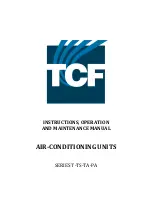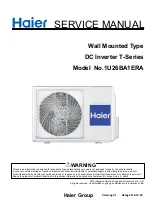
Refrigeration Maintenance
10-45
LIQUID LINE SOLENOID (LLS) AND LIQUID RETURN CHECK VALVE TEST
(MULTI-TEMP UNITS ONLY)
A leaking liquid line solenoid can cause its zone to cool when it is in null. A zone will not cool if its liquid line solenoid does
not open. A leaking liquid return check valve can reduce the cooling capacity of its zone. Use the following procedure to test the
liquid line solenoids and the liquid return check valves.
1. Attach a gauge manifold to the suction service valve and the discharge service port. Attach another low pressure gauge to the
suction access port located in the suction line near the accumulator inlet. Low loss fittings must be used on the hoses connected
to the discharge service port and the suction access port.
2. Operate the unit with all zones in low speed cool.
3. Front seat the receiver tank outlet valve and allow the low side to pump down to 0 to 5 in. Hg vacuum (0 to -17 kPa).
4. Turn the unit Off.
5. Front seat the suction service valve to isolate the low side while it is still in a vacuum.
6. Watch the low pressure gauge attached to the suction access port. The low side pressure should not rise. It it does, there could
be a leak through one (or more) of following components: hot gas solenoids, purge valve, or hot gas bypass solenoid.
7. Backseat the receiver tank outlet valve to allow liquid refrigerant into the liquid lines.
8. Watch the low pressure gauge attached to the suction access port. The low side pressure should not rise. It it does, one (or
more) of liquid line solenoids or liquid return check valves is leaking.
a.
Remove the remote evaporator covers from the remote evaporators.
b. Check the temperatures of the refrigeration lines on both sides of each liquid line solenoid and each liquid return check
valve by hand. A temperature difference between the two sides of a liquid line solenoid or liquid return valve indicates
it is leaking.
9. Use the Mechanics/Premium HMI Control Panel to enter the Interface Board Test Mode. Refer to the appropriate
Microprocessor Diagnostic Manual for specific information about the Interface Board Test Mode.
10. Momentarily energize the liquid line solenoid in the zone being tested with the Interface Board Test Mode by pressing the
TEMP ON key. The low side pressure should rise. If the low side pressure does not rise, the liquid line solenoid in that zone
is not opening. Check the continuity of the wiring and the solenoid coil before assuming the solenoid is faulty.
11. Repeat step 10 for the other zone (or zones) being tested. If the low side pressure rose enough to be equal with the high side
pressure when the solenoid was energized, open the suction service valve and repeat steps 2 through 7 to pump down and
isolate the low side before repeating step 10 for the other zone (or zones).
12. Back seat the suction service valve. Perform a “Refrigerant Gauge Removal” procedure.
LOW PRESSURE CUTOUT SWITCH (LPCO) TEST (T-500R/T-DAIRY ONLY)
The LPCO is used in these units starting in June 2012. If the suction pressure drops to 13 ± 3 in. Hg of vacuum (-44 ± 10 kPa),
the switch opens the LPCO/HPCO circuit to stop the unit. Use the following procedure to test the switch.
1. Attach a gauge manifold to the suction service valve and the discharge service valve.
2. Operate the unit in low speed cool.
3. Close the receiver tank outlet valve to pump down the low side.
4. When the suction pressure drops to 13 ± 3 in. Hg of vacuum (-44 ± 10 kPa), the LPCO should open and the unit should stop.
5. If the LPCO opens too soon or does not open to stop the unit, it must be replaced.
LOW PRESSURE CUTOUT SWITCH (LPCO) REPLACEMENT
Removal
1. Pump down the low side and equalize the pressure to slightly positive.
2. Disconnect the wires and remove the LPCO from the suction adapter.
Installation
1. Apply a refrigerant Loctite to the threads of the LPCO.
2. Install and tighten the LPCO and reconnect the wires.
3. Open the refrigeration valves and check for leaks before placing the unit in operation.
CAUTION: Do not run scroll compressor in a vacuum for more than 1 minute.
Содержание T-1000R
Страница 14: ...Safety Precautions 2 6 Warning Decals 2e24151g0 ...
Страница 18: ...Specifications 3 4 ENGINE CLUTCH Engagement 600 100 RPM Dynamic Torque 66 fT lb 89 5 N m minimum 1600 RPM ...
Страница 34: ...Maintenance Inspection Schedule 4 10 ...
Страница 57: ...Unit Description 5 23 Purge Mode UT Series 1 3 4 5 2 ...
Страница 67: ...Unit Description 5 33 Zone 1 Cool and Zone 2 Cool UT SPECTRUM Units ...
Страница 69: ...Unit Description 5 35 Purge Mode UT SPECTRUM Units ...
Страница 71: ...Unit Description 5 37 Zone 1 Cool and Zone 2 Heat UT SPECTRUM Units ...
Страница 72: ...Unit Description 5 38 ...
Страница 74: ...Diesel Electric Menu 6 28 Adjust Brightness 6 29 Time 6 30 ...
Страница 120: ...Operating Instructions Standard HMI 7 18 ...
Страница 152: ...Engine Maintenance 9 14 T Series Fuel and Oil System Components TK 376 ...
Страница 154: ...Engine Maintenance 9 16 T Series Fuel and Oil System Components TK 270 ...
Страница 156: ...Engine Maintenance 9 18 UT Series Fuel System Components AMA768 ...
Страница 172: ...Engine Maintenance 9 34 T Series Engine Mounting Components for 2 Cylinder Engine ...
Страница 184: ...Engine Maintenance 9 46 ...
Страница 238: ...Refrigeration Maintenance 10 54 ...
Страница 246: ...Clutch Maintenance 11 8 ...
Страница 258: ...Structural Maintenance 12 12 ...
Страница 264: ...Mechanical Diagnosis 13 6 ...
Страница 265: ...14 Electric Standby Diagnosis ...
Страница 268: ...Electric Standby Diagnosis 14 4 ...
Страница 269: ...15 Refrigeration System Diagnosis ...
Страница 272: ...Refrigeration System Diagnosis 15 4 ...
Страница 280: ...Remote Evaporators 16 8 ...
Страница 282: ...Wiring Diagrams and Wiring Schematics 17 2 ...
















































